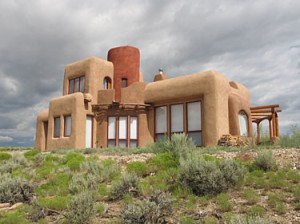Off-the-grid homes operate independently of all public utility services. Gas, electricity, water, sewage disposal – it’s all generated supplied or disposed of by independent means.

Off the grid home made with adobe and strawbales
Estimates for off-grid homes are approximately 300,000 off-grid homes in the United States and another 40,000 in the UK[1].
Why would you want to go off-grid? Off-gridders span a broad church. Some want to be self-sufficient or do it because of environmental concerns; maybe their homes are remote and can’t be connected to the grid; and if you live in a boat or tent you probably don’t have much choice! At the other end of the scale are those who adopt an almost survivalist mentality and wish to be free from what they perceive as government or big business having control over their lives.
But forget the image of off-gridders being first cousin to Grizzly Adams; as products such as solar panels, wind turbines and water recycling systems become available to domestic users more and more people are turning, to various degrees to this lifestyle.
If you want to try off-grid living, how do you start? In a word, small. Don’t sell your house and move to a shack in the Adirondacks without at least trying the off-grid lifestyle first.
Off the grid Low Impact Woodland Home
Try running some appliances with solar power and see if you can cope with the energy it provides. You could install a few solar panels to power a laptop table lamp or radio for example, and see how you get on.
Hold off on the amount of water you use. Recycle your grey water (from the bath or washbasin) and use it to water the garden or flush the toilet. Get some rainwater butts and store rainwater to reduce your consumption from the mains supply. You could also get a wood-burning stove to heat your home and reduce your reliance on electricity or gas.
Contemporary off the grid home
These are simple changes which won’t cost you much money. If these work, maybe it’s time to step things up. This will involve laying out some cash though. If you want to be self sufficient in energy you’ll need to install a solar thermal system to provide hot water for washing and laundry. You can generate electricity to power your appliances with either solar PV or through wind generation technologies, but be sure to research them thoroughly to see how much energy you’re likely to generate before you invest in them.
Off-gridders are keen to point out that living off-grid doesn’t throw you back to the stone age. You can maintain a 21st century lifestyle, but you’ll be more aware of what you consume in terms of energy, natural resources and consumer products. You’ll turn lights off when you’re not in the room. You’ll take more care with how you use energy-hungry appliances: you’ll put on a fleece jumper before switching on the electric heater, and wear that shirt one more day before throwing it in the washing machine. plan it right, and you can have mod cons. But when the energy to run them comes from solar panels on your roof and a wind turbine in your garden you’ll be a lot more careful as to how you use it[2].